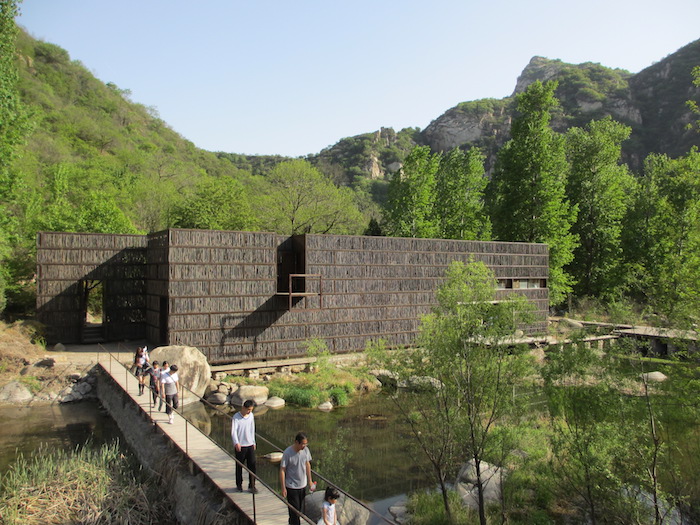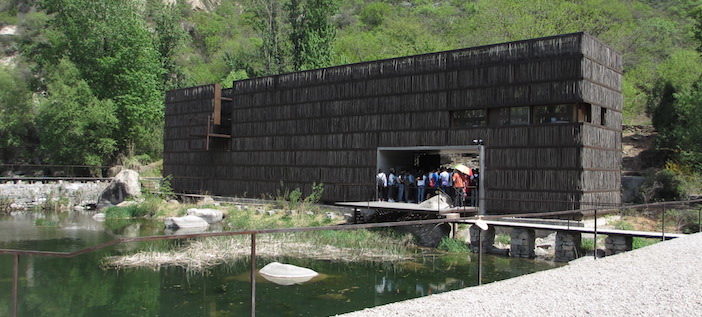Update: On September 19 2017 Liyuan Library was closed by the authorities, following complaints about pirated and uncensored material. We strongly advise you to check the current status before making the long trip to visit it.
Libraries have held an integral role throughout human history as a place where knowledge is stored, protected, and passed down from generation to generation. But due to limited access and living in the age of the internet, these houses of information have mostly become obsolete.
We say mostly because there is still a certain fondness that exists for the utilitarian functions of a library, and the sort of conduciveness for learning and quiet ambiance such places possess. That’s why we decided to venture out to the village of Jiaojiehe, in the mountainous region of Huairou, to check out this minimalist architectural wonder known as the Liyuan Library.
Liyuan Library was designed and built by Li Xiaodong, an architecture professor at Tsinghua University in 2011. Li saw it as a way to draw visitors to the forgotten village, and help promote economic development. Since it was constructed, it has been featured in numerous architectural and international publications, not only because of its unique structural characteristics but also because of its isolated and serene location.

Using the village and its landscape as his inspiration, one of the building’s most distinct features are its use of local fruit tree branches along the roof and exterior to almost camouflage the facade with its surroundings. This decision also gives Liyuan’s interior the perfect amount of ambient lighting during the day and helps keep the glass and steel box structure relatively cool during warmer months by providing just the right amount of shade. This combination of a unique design and remote location has since turned this sleepy village outpost into a travel destination for about 400 people every weekend between mid-Apr to mid-Oct. Getting there, however, is no real easy feat. It is a 50km drive from the city center, which depending on traffic can take you up to three hours to reach. We recommend arriving early because on the weekend lines can get painfully long. We first rode the subway to Houshayu on Line 15 and from here caught a Didi, who managed to bring us the rest of the way. It wasn’t easy to find, and we had to turn around at one point because the road Didi directed us to take was closed. It also got even more confusing because there wasn’t much cellular service as you begin to traverse up the mountain. All in all, though, the drive up these summits provided many stunning views. There were a couple of moments where you could even spot unrestored guard towers on the Great Wall that have probably been untouched for years due to their hard to reach strategic positions.
Upon entering the site, you’ll start to see a couple of signs pointing you in the way of Liyuan Library and pass a couple of small restaurants. If you arrive by car, they ask that you pay a 5 RMB parking fee. Once you get out of the car, there’s a small concession stand that can come in handy as this is your last chance to get some liquids or a quick snack before reaching the library, which is about a five-minute walk down a gravel road.
The scene is immediately impressive. The elongated box structure covered in dead tree limbs is perfectly nestled among mountains and a small pond with a greenish blue hue. The one thing that didn’t look tranquil however was the line of 30 people waiting to get into this minimalist house of knowledge. This was about 1:30 pm, and they had just reopened after their lunch break. This was also when we discovered that the library has a limited capacity of 40 people at all times. Though the restriction makes sense, it can be a little troubling when you just traveled all this way, and you know that nobody currently flipping through their pages on the inside will leave for a while. It’s unlikely that anyone goes to a library this remote to just walk inside, check it out, then hit the road. So we ended up waiting for about two hours just to get in. Luckily, it was mostly in the shade, and there were plenty of places to play while you or someone else in your party maintains that precious place in line.

After reaching the front of the line, when it’s your turn to enter you’ll be asked to remove your shoes to keep the space clean, so make sure to come wearing a clean pair of socks to avoid adding some unpleasantness to the lovely woodsy odor of the venue. The interior is equally impressive as the facade, filled with wooden steps and open floor space for sitting. As we mentioned before, there is great natural lighting provided as the sunlight is obstructed by thousands of branches fastened to the exterior. Just enough light to get you in the mood to start digging into the book of your choosing.

A majority of the books here are in Chinese, but not all. Both the kids and adult sections have a decent amount of books in English, but nothing compared to your neighborhood bookseller. We realized quickly that this was more of a place to soak in the atmosphere, not their shallow collection of used books, which included titles ranging from JD Salinger’s Nine Stories and Shel Silverstein’s The Giving Tree, to less desirable informational reads like Skype Hacks: Tips & Tools for Cheap, Fun, Innovative Phone Service. Despite this lack of choice, it was probably the most “Instagrammable” library we had ever visited. That’s what a majority of the people seemed to be doing there, despite the numerous signs prohibiting photography.
We should warn you that even though this space is conducive to reading, it isn’t very safe if your child is one that can’t sit still for extended periods of time. There are sections that have a pretty high drop due to the design, neglecting the use of guard rails likely for aesthetic reasons. This is why in their comprehensive set of rules that can be found on their WeChat account they state that children under the age of 12 must be accompanied by an adult over the age of 18 at all times, and children under the age of three will not be admitted. They also make it clear that you must watch your step at all times, and they can’t be help responsible for any injuries that may occur. It was the first time that we’ve seen the term “use at your own risk,” to detail the potential harm that could be caused by a library.

After spending an hour reading our Kindle in the company of other hardcore readers, we decided it was time to soak in a little more of the scenic offerings available around the perimeter, which can also be a pleasant place to get some reading done. As we were exiting, we encountered a little shouting match with an angry visitor who arrived about an hour before closing time to at least an hour long wait in line. Don’t let this happen to you by doing your utmost to get there when they open at 9 am, to ensure hours of reading pleasure. As the old saying goes, “the early bird gets the worm,” or in this case the bookworm we suppose.




